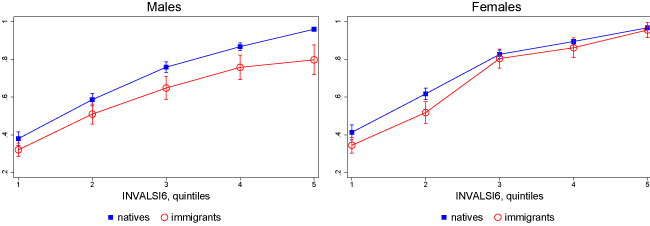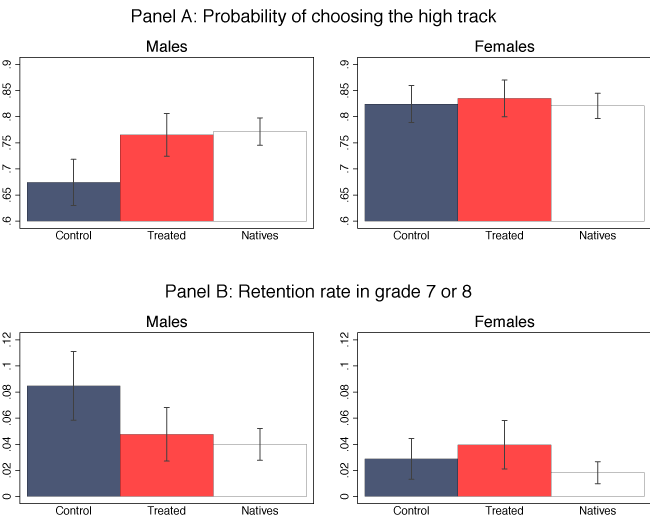
Career counselling helps close the immigrant-native gap in high-school track choice, grade repetition, and cognitive skills
The share of students with an immigrant background has considerably increased over the past decades, accounting for 12% of 15-year-old students in the average OECD country in 2012 (OECD 2015). Immigrant children tend to have lower performance in mathematics and reading, educational attainment, and labour market outcomes than those with native-born parents (OECD 2017). The schooling system faces growing challenges in ensuring skill development in a diverse student population and promoting social cohesion. These are crucial policy concerns in all advanced societies.
Stratification in high-school tracks exacerbates educational segregation of immigrant children
The challenge of ensuring equal opportunities for all children is intensified in schooling systems characterised by stratification in high school tracks. This is because early tracking may lead to the educational segregation of children from disadvantaged backgrounds in lower quality schools. This could ultimately have long-term effects on the skills and occupational careers of immigrant children, reducing upward social mobility and creating unequal opportunities (Guyon et al. 2012, Brunello and Checchi 2007).
In the Italian context, we find that immigrants tend to choose vocational over technical or academic-oriented curricula, relative to native students with similar abilities measured by standardised test scores (INVALSI), as shown in Figure 1. The gap in high school choices is greater for male immigrants and it mirrors an analogous differential in failure rates and in the track recommendations received from teachers. The gap in track choice for boys persists along the entire distribution of ability, while for girls it is found only at the bottom of the distribution. This gender pattern is consistent with evidence from other countries according to which boys are increasingly lagging behind in low socioeconomic status (SES) families (Autor et al. 2016).
Figure 1 Educational segregation of immigrant children in Italy

Notes: The figure compares the probability of enrolling in the high-track between immigrant and native students, by quintiles of performance in the standardized test in grade 6 (INVALSI6).
Evaluating a career counselling intervention in Italy
In a recent paper, we report the findings from an evaluation, conducted with the financial support of three Italian foundations1 and the collaboration of the Italian Ministry of Education, to estimate the impact of a tutoring and career counselling intervention offered to immigrant children displaying high academic potential (Carlana et al. 2017). The Equality of Opportunity for Immigrant Students (EOP) programme included a number of meetings which helped students reflect on their aspirations and potential. This was done through a series of psychological exercises based on social cognitive career theory (Lent et al. 1994).
The programme was offered in 70 middle schools randomly chosen from a sample of 145 in northern Italy, with the remaining 75 serving as controls. Within each school, we selected the 10 immigrant students with the highest standardised test scores in grade 6. In treatment schools these students were invited to participate in EOP through grades 7 and 8, whilst in control schools, they were not offered such a programme.
Impact on track choice and grade repetition
The research team finds that the EOP programme was successful in reducing educational segregation. Male treated students are less likely to repeat the same grade (known as the retention rate) and have a higher probability of attending a demanding track (as opposed to a vocational one), compared with immigrant students in control schools who started at a similar level of academic ability. This information is shown in Figure 2. Furthermore, the gap with a group of natives with similar test score in grade 6 was completely closed thanks to this programme. The gap between immigrant females in the top of the distribution and ‘comparable’ native females is not statistically significant. Therefore, the effects of the treatment are in the same direction but smaller and not significant for girls.
Figure 2 The impact of EOP on track choice and grade retention

Mechanisms: The importance of aspirations and the track recommendation of teachers
To shed light on the mechanisms underlying these effects, we collected data on academic performance and psychological traits. We find that male treated students display an improvement in cognitive skills, as measured by their standardised test score at the end of grade 8. Importantly, their soft skills also improve – they have higher aspirations and more confidence in their own abilities, and they perceive that environmental barriers will play a smaller role in their future choices relative to the control group. All these improvements seem to have been internalised by teachers, who recommend treated boys for more demanding high schools. No effect is found on teachers’ recommendations for treated girls, whose academic performance and aspirations were unaffected by the programme.
Following the approach of Heckman et al. (2013), we decompose the impact of EOP on the educational choices of males into experimentally induced changes and changes in other (unmeasured) factors. We find that changes in aspirations and in teachers’ recommendations induced by the treatment explain a sizable portion of the effect on track choice. The effect of increases in test scores is negligible.
Long-term effects
Our administrative data allow us to follow all students in our sample through the first two years of high school. This is important in order to assess the longer-term effects of EOP on students’ educational careers, particularly considering the risks associated with enrolling in more demanding high school tracks. Reassuringly, treated students are neither more likely to be held back in a grade, nor forced to take make-up exams after the summer (as opposed to being directly admitted to the next grade). They are also no more likely to drop out. Therefore, treated students did as well as control ones, despite attending (on average) more demanding high schools.
Spillover effects
Finally, we analyse the impact of the intervention on native and other immigrant classmates. We find evidence of positive spillovers of the programme on immigrant peers of treated students, while there is no effect on natives.
Policy implications
The findings of this study are useful to inform policymakers on promising avenues to close the gap between the career choices of immigrant and native children. Gains in terms of aspirations through career counselling and absence of stereotypical recommendation by teachers are crucial in achieving higher equality of opportunities between immigrants and natives.
References
Autor, D, D Figlio, K Karbownik, J Roth, and M Wasserman (2016), “Family disadvantage and the gender gap in behavioral and educational outcomes”, NBER Working Paper.
Brunello, G and D Checchi (2007), “Does school tracking affect equality of opportunity? New international evidence”, Economic Policy 22(52): 781–861.
Carlana, M, E La Ferrara and P Pinotti (2017),“Goals and gaps: Educational careers of immigrant children”, CEPR Discussion Paper No. 12538.
Fryer Jr, R, and S Levitt (2004), “Understanding the black-white test score gap in the first two years of school”, Review of Economics and Statistics 86(2): 447–464.
Guyon, N, E Maurin, and S McNally (2012), “The effect of tracking students by ability into different schools: A natural experiment”, Journal of Human Resources 47(3): 684–721.
Heckman, J, R Pinto and P Savelyev (2013), “Understanding the mechanisms through which an influential early childhood program boosted adult outcomes”, American Economic Review 103(6): 2052–86.
Lent, R, S Brown and G Hackett (1994), “Toward a unifying social cognitive theory of career and academic interest, choice, and performance”, Journal of Vocational Behavior 45(1): 79–122.
OECD (2015), “Immigrant students at school- easing the journey towards integration”, OECD Publishing.
OECD (2017), “How does having immigrant parents affect the outcomes of children in Europe?”, Migration Policy Debates OECD n°14. OECD Publishing.
Endnotes
[1] This project was funded by Fondazione CARIPLO, Compagnia di San Paolo and Fondazione Cassa di Risparmio di Padova e Rovigo.



